Читать книгу Manual of Laboratory Testing Methods for Dental Restorative Materials - Paromita Mazumdar - Страница 13
Good to Know
ОглавлениеFor a DTS test, the fracture line doesn't always occur along the central line, thus giving false results and making the test inaccurate.
The diametral tensile strength (DTS) test is useful for materials that exhibit very limited plastic deformation and where information regarding stretching or elongation resistance is required. The DTS is a property described by American Dental Association (ADA)/American National Standards Institute (ANSI) Specification 27 for characterizing dental composite restoratives (DCR). It represents the minimal stress that a body will withstand without rupture when tensile loads are applied. The DTS test is considered useful because masticatory forces are frequently applied obliquely and tend to create tensile stress. A UTM is generally used to determine the tensile strength of a material. Materials which plastically deform would produce erroneous DTS values and also would be expected to display strain rate sensitivity. Composite resins are subjected to complex intraoral forces during mastication and parafunctional habits. Of the three tests used in this study to replicate intraoral forces, diametral tensile is the most difficult to interpret. Failure must occur in the center of the specimen along the diameter due to tensile forces if the diametral test is to yield useful results. The method was used to evaluate the influence of different cross‐head speeds on DTS of a resin composite material (Tetric N‐Ceram) by Anubhav Sood et al. in 2015 where they found that the cross‐head speed variations did not have a significant effect on the DTS of the resin composite [8].
